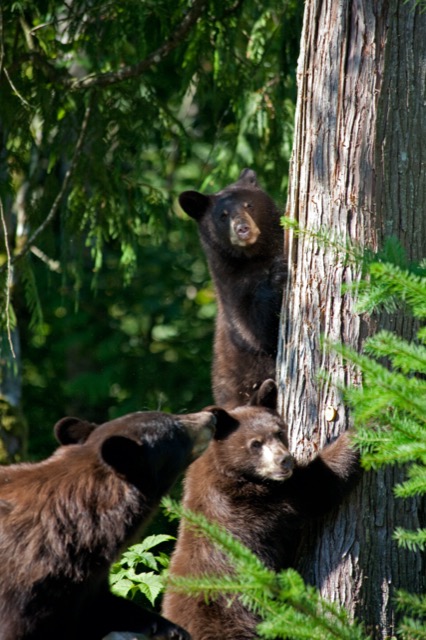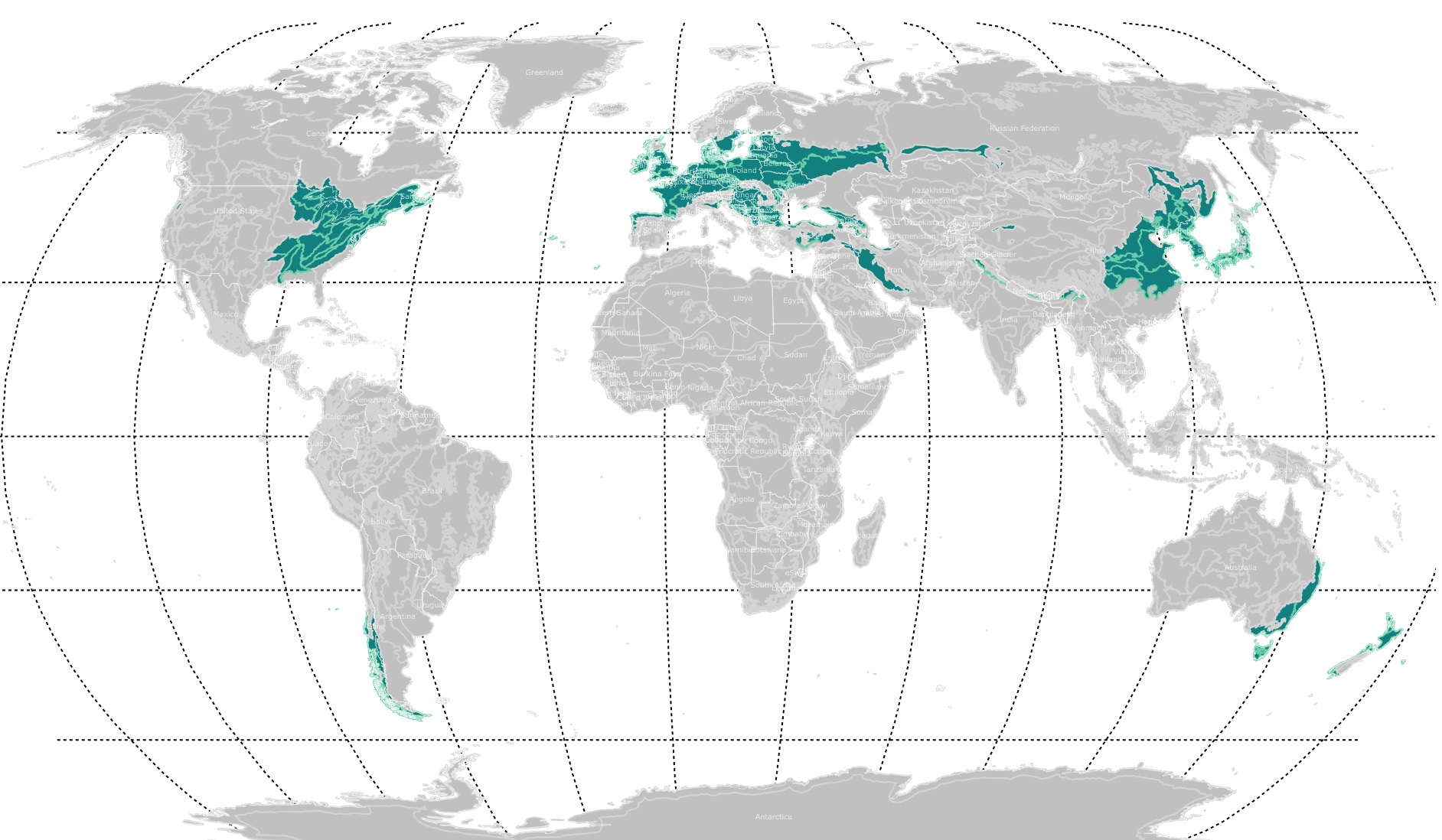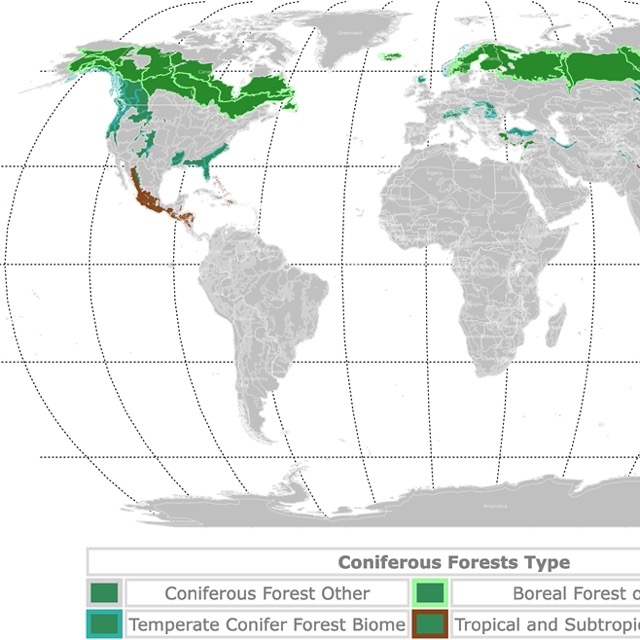World Map of Temperate Broadleaf and Mixed Forests
This map shows the Temperate Broadleaf and Mixed forest biome worldwide, colored in green. To see the names and types of each of its ecoregions, hover over the map. Zoom in the map to take a closer look! For more information, scroll down.
What are Temperate Broadleaf and Mixed Forest?

These are forests easily recognized because their trees change color and lose their leaves during fall and winter. Because of this characteristic, they are also called temperate Broadleaf Deciduous Forests.
The trees change colors because shorter days make the plants absorb chlorophyll from their leaves, resulting in gorgeous orange and red hues.
In winter, absorbing frozen water is not possible, so the trees drop their leaves, needing less water. Deciduous forest trees also have a thick bark to protect them from cold winter temperatures.

They are named mixed forests because the broadleaf may be mixed with pine trees and spruce-fir. Sometimes Taiga and Temperate Broadleaf forests overlap.
Broadleaf trees are gymnosperms, which means they have flowers. Angiosperms like pine trees have no flowers.
Temperate trees flower in spring and grow during spring and summer, about 6 months of the year. Small plants bloom at the beginning of spring when the trees have no leaves and enough sun reaches the bottom ground, NASA.
Broadleaf trees grow in rich soils as they are nutrient demanding. The soils are not as acidic as under needle leaf trees. The leaves that fall in autumn provide the soil with rich humus that decomposes rapidly.
In areas with a similar climate, pines replace broadleaf forests if the soils are sandy.
Broadleaf Forests Locations
Temperate forests are located in mid-latitude areas. This means they are mainly between the polar regions and the tropics. That is between 30 degrees North and the North Pole and 30 degrees south and the South Pole.

These locations in the southern hemisphere occur in South America, South Africa, Australia, and New Zealand. Nevertheless, there is a higher mixture of broadleaf and needle leaf in these southern forests. This is thanks to their geologic past.
In the northern hemisphere, these locations broadly occur in Central Europe, eastern Asia, and North America. Unfortunately, there is very little plant diversity in European and Chinese Forests, as most lands were cleared for agriculture.
It is also believed little diversity in Europe occurred during glaciation as these forests could not migrate south due to the Mediterranean.
The highest diversity of deciduous forests is found in Korea and the United States. This is especially true for Kentucky, Tennessee, North Carolina, and Virginia, source Radford.
To learn about North American broadleaf forests Amazon has Forest Walking: Discovering the Trees and Woodlands of North America. The the authors of this book, share experiences and observations from visiting forests across North America: from the rainforests and redwoods of the west coast to the towering white pines of the east, and down to the cypress swamps of the south and up to the boreal forests of the north.
The Climate of Broadleaf Forests
Temperate forests have summers that average 70°F (21°C) and winters that reach below 32°F (0°C).
These forests have four seasons, with cold winters and hot summers.
On average, they get 750 to 1500mm of rain a year. Precipitation is evenly distributed throughout the year.
Vegetation in Broadleaf Forests
The further a region is from the poles in these forests, the higher its plant diversity.

These broadleaf forests also have multiple layers:
- Forest floor with moss, lichen, ferns, and wildflowers.
- Shrubs.
- One or two hardwood tree levels.
Trees may produce a large number of seeds ("mast") one year, followed by a few seeds the following years.
A mix of deciduous trees and evergreens like Broadleaf trees include oaks (Quercus spp.), maples (Acer spp.), hickory (Carya spp.), chestnut (Castanea spp.) (chestnuts produce conkers!), and beeches (Fagus spp.).
Intact humid locations have American elm (Ulmus americana), tuliptree (Liriodendron tulipifera), and sweetgum (Liquidambar styraciflua) source: ecologypocketguide.com.
Other plants include mountain laurel, Birch (Betula spp.), and azaleas. Lianas high in the forest canopy include poison ivy, grape, and Virginia creeper. There are also shrubs, perennial herbs, and mosses.
Wildlife in Broadleaf forests

To survive the cold winters, birds and bats migrate south in winter. In the meantime, other bats and mammals hibernate.
Common animals in these forests feed on nuts and acorns or are omnivores. Jays and squirrels take advantage of masts (nuts) and store them during winter.
Plants in North America and Asian broadleaf forests are similar. Nevertheless, if you focus on the animals, they will be drastically different, Blue Planet.
Some Asian animals include the red-crowned crane, the red panda, musk deer, red deer, sika deer, leopard, lynx, and Siberian tiger.
North American Broadleaf Forest Animals

Thanks to the last glaciation, there is a high diversity of salamanders and turtles, especially in North America, source University of Puget Sound.
Examples of animals in these forests in North America include:
- Herbivores: squirrel, chipmunk, porcupines, and white-tail deer.
- Omnivores: opossum, skunk, raccoon, and black bear.
- Carnivores: mountain lions, red foxes, wolves, and bobcats.
Birds found in these forests include woodpeckers, turkeys, songbirds, owls, and hawks.
Resources for Broadleaf Forests Map
The shapefiles to create the map with ecoregions of the world were obtained from WWF. The shapefiles with the countries of the world were obtained from Natural Earth.
This map will be updated with new data! To receive updates on this and more nature maps, join my email list!!!!!!!
Made by Luz K. Molina with D3.js.







